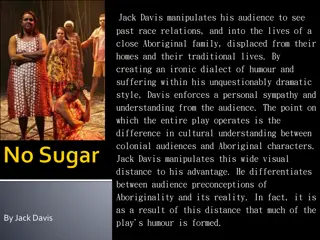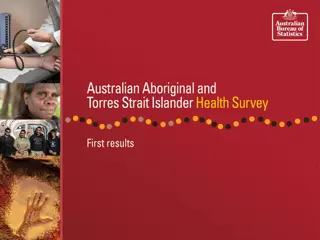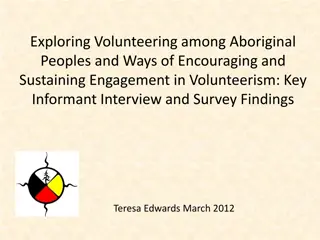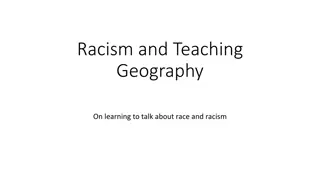Understanding Racism and Resilience in Aboriginal Australian Students' Education
Explore the complexities of racism and resilience among Aboriginal Australian students through a critical examination of cultural perspectives, epistemological racism, and the manifestations of modern and old-fashioned racism in education settings.
Download Presentation

Please find below an Image/Link to download the presentation.
The content on the website is provided AS IS for your information and personal use only. It may not be sold, licensed, or shared on other websites without obtaining consent from the author. Download presentation by click this link. If you encounter any issues during the download, it is possible that the publisher has removed the file from their server.
E N D
Presentation Transcript
Bubalamai Bubalamai Bawa The search for resiliency The search for resiliency against racism for Aboriginal Australian students against racism for Aboriginal Australian students Bawa Gumada Gumada (Healing the Wounds of the Heart): (Healing the Wounds of the Heart): Gawaian Bodkin-Andrews Warawara Department of Indigenous Studies, Macquarie University & National Indigenous Research and Knowledges Network gawaian.bodkin-andrews@mq.edu.au
Aboriginal Australian peoples possess cultures that are a great deal more than simple or primitive Our cultures, instead, are based on the scientific premise of observation and experience, and the results recorded, through story, in the memories of future generations (Bodkin, 2013, p.2). Midan Yewing What you see Barkolo Yewing What others see Duragai Yewing What is Maridyulu Yewing What was Wugul Yewing What will be
Theory demands critique on how racialised relationships between the researcher and the researched are perpetuated . This critique is extended to making transparent the racialised representation through erosion and denial of agency (Martin, 2004, p. 51) Epistemological racism (Sheurich & Young, 1997). Epistemological racism means that our current range of research epistemologies arise out of the social history and culture of the dominant race... While excluding the epistemologies of other races/cultures (p. 8). 1. The Others histories are not seen as legitimate; 2. The Others becomes distorted, sensationalised, and pathological; 3. Other scholars must be bi-cultural. One of the worst racism, though, for any generation or group is the one that we do not see, that is invisible to our lens the one we participate in without consciously knowing or intending it (Sheurich & Young p. 12).
Racism? Psychological research focuses largely on attitudes and behaviours anantipathy based upon a faulty and inflexible generalization. It may be felt or expressed. It may be directed toward a group as a whole, or toward an individual because [they are] a member of that group (Allport, 1954, p.4 italics added) Consequently, only extremes of behaviour come under scrutiny, deflecting attention from everyday racism when most people claim to not to be racist, it is this extreme or exaggerated form to which they refer (Hollinsworth, 2006, p.43)
Old-fashioned VS Modern Racism Old-fashioned: is the overt expression of beliefs and stereotypes based upon segregation and biological superiority: I wouldn't like any member of my family to marry an Aborigin[al] (Pedersen & Walker, 1997) Modern: is an ambivalence towards the disadvantages suffered by minority groups, resulting in a general resistance to correcting the status-quo: Over the past few years, the government have shown more respect for Aborigin[als] than they deserve (Pedersen & Walker, 1997)
1984 58% of high school students reported holding negative beliefs about Aboriginal Australians (Jordan, 1984); 1994 50% of WA residents reported high levels of old-fashioned racism (Walker, 1994). 1997 27.2% of WA residents scored high in old-fashioned racism -57.9% high levels of modern racism (Pedersen & Walker, 1997). 2000 23.8% of participants scored high in old-fashioned racism -59.9% of participants reported high levels of modern racism (Pedersen, et al., 2000) 2009 Across 4020 NSW residents, only 12% held racially blatant prejudicial attitudes (Dunn, et al., 2009)
Beyond Blue (2014) - - - - - - - - - - 10% would purposely not sit next to an Aboriginal Australian; 21% would move away from an Aboriginal Australian; 21% would watch an Aboriginal Australian when shopping; 42% believe Aboriginal Australians are given unfair advantages 37% believe Aboriginal Australians are lazy; 31% believe Aboriginal Australians should behave like other Australians; 20% believe racist terms to describe Aboriginal Australians are not bad. 9% would not hire an Aboriginal Australian; 6% would verbally abuse an Aboriginal Australian; 12% would tell jokes about Aboriginal Australians; What s Missing? Returning to Dunn, et al. s (2009) research: - 63% of Aboriginal Australians experienced racism; - 45% of Muslim Australians experienced racism. Image by Sam Wallman
Western Voice - Indigenous Voice (Pedersen & Walker, 1997) (Mellor, 2004) Old fashioned Individual Overt Blatant Physical threats, Verbal abuse Biological superiority Segregation Institutional Racism? Discrimination Unfair Punishment, Denial of Services Ambivalence, Accepting status quo Modern Covert Subtle Denial of History Media misrepresentation Macro
The argument that there is a cultural norm against racism... may thus be misleading, at least in the Australian context. Not only was it the norm for participants in this study to have experienced racism in their daily lives but much of the racism experienced was one-on- one, blatant, old fashioned racism (Mellor, 2003, p. 483).
Zubrick, et al., (2006) found that Aboriginal youth were: - 2+ times more likely to drink, smoke, suffer from clinically significant emotional and behavioural problems, and have suicidal thoughts. Larson, et al., (2007) found that Aboriginal adults were: - 3.6 times more likely to suffer lower levels of physical health; - 9.2 times more likely to suffer lower levels of mental health. Priest, et al., (2010) found that Aboriginal parents were: - 3.6 times more likely to report drug problems; and - children were 1.62 times more likely to be become ill. Priest, Paradies, Stuart, & Luke (2013) found that for Aboriginal youth - 52.3% experienced racism; and were - 3.7 times more likely to report lower levels of mental health; - 2.0 time more likely to suffer from depression.
Priest, Ferdinand, Perry, Paradies, & Kelaher (2014) found that for a multicultural sample of school students: - 33.2% experienced racism directly; - 65.6 % witness racism vicariously. Bodkin-Andrews, et al., (2010) found that Aboriginal high school students were: - put at a 5-10% disadvantage in grades and achievement tests across English, math and science. - strongest association was with Academic Disengagement; - Similar, but weaker effects were found for non-Indigenous Students.
From racist taunts in the school playground to racial vilification in the media, the burden of confronting that abuse falls on the Aboriginal people at whom it is directed... We know as Aboriginal people that in having to find resilience to oppose racism, the effect can be tiring. (Zubrick et a., 2006, p. xi) .
Study 1 - Wingara Mangamai (dream of understanding) A total of 562 secondary students (Years 7-11) drawn from five secondary schools across New South Wales: - Mean age of 13.57 years - 47.62% female and 52.38% male; - 82 First Nations, 279 Anglo Australian, and 200 East/Asian; - 47 Student interviews on their experiences of racism. Study 2 New Solutions for Maximising Indigenous Students Full Potential A total of 1440 secondary students (Years 7-10) drawn from five secondary schools across New South Wales: - Mean age of 13.57 years; - 51.1% female and 48.9% male; - 372 Indigenous Australian and 1068 Anglo Australian. Study 3 Bubalamai Bawa Gumada In depth interview with 24 Aboriginal Australian community representatives within the Sydney Region (Elders, Business Owners, Academics, CEOs)
Wingara Mangamai (dream of understanding) Measured experiences of Interpersonal Racism (e.g., name calling) and academic outcomes of Hopelessness, English and Math Self-ratings, and Aspirations to go to University. Confirmatory Factor Analysis and Equivalence Testing A series of tests to determine the extent items reflect the theoretical underlying factor structure, and the extent to which one may assume that a CFA model is equivalent in meaning across differing groups (Byrne, 2012). Due to sample size limitations, the sample was split into Anglo-Australian (n = 279),and other -Australians (n = 282): RMSEA .07 .07 .07 .07 CFI .95 .95 .95 .94 Model 1: Free Model 2: Factor Loadings Model 3: Factor Covariance Model 4: Intercepts Acceptable Acceptable Acceptable Acceptable
Descriptive Statistics Racism Hopelessness English Ratings Mean Math Ratings Mean Uni Aspirations Frequency Mean Mean Frequency First Peoples (n=83) Anglo-Saxon (n=279) Asian/Eastern (n=200) 59% 2.79 53% 2.59 3.43 3.24 53% 1.86 33% 2.41 3.49 3.25 76% 2.43 52% 2.71 3.49 3.42 Correlations First Peoples .48* -.25* -19^ ns Anglo-Saxon Asian/Eastern .29* ns -.12^ -.22* Hopelessness English Rating Math Rating University Asp .44* -.16* ns ns
Agents of Resiliency? Utilising an Unconstrained Latent Interaction Modelling approach (Marsh, Wen, & Hau, 2006), varying positive psychological constructs were examined to determine if they could buffer the impact of racism. Sense of Positive Cultural Identity Research on the relations between varying forms of identity and student outcomes have produced mixed results: - Some evidence has questioned its importance within the schooling system (Hattie, 2009; Amosa, Ladwig, Griffiths, & Gore, 2007); - Other evidence has strongly attested to the worth of promoting identity within the classroom (Craven & Magson, 2014; Munns, O Rourke, & Bodkin-Andrews, 2013; Purdie, et al., 2000; Sarra, 2011). Cultural Identity Scale (Phinney, 1992): Ameasure assessing the extent to which students are attached to their culture. Multiculturation (Bodkin-Andrews, et al., 2010). A measure capturing the extent to which students felt that their culture is respected by others
First Nations Students and Identity Positive Identity Multiculturation -- .21^ -- .21^ -- Hopelessness English Ratings Math Ratings University Aspirations -- -- -- Cultural Identity significantly interacted with Racism over Academic Hopelessness: - Interpreted as a weak exacerbating effect where the impact of racism increases as students attachment to their culture increases.
Anglo-Australian, Asian/Eastern Students and Identity Positive Identity Anglo -.22* .16* .17* .12^ Multiculturation Anglo -.16* .22* .19* .16* Asian -- -- -- -- Asian -- -- -- -- Hopelessness English Ratings Math Ratings University Aspirations Cultural Identity and Multiculturation significantly interacted with Racism over Academic Hopelessness for Anglo-Australian students: - Interpreted as a buffering effect where the impact of racism is negated as students attachment to their culture increases.
Emotional and Social Intelligence There has been an increasing push to recognise the value of emotional intelligence within schooling environments (Parker, Summerfeldt, Hogan, & Majeski, 2004): - Recent evidence suggests that emotional intelligence may not only directly impact upon higher levels of achievement, but also more strongly interact with cognitive intelligence in its influence over achievement (Qualter, Gardner, Pope, Hutchinson, & Whiteley, 2012). Emotional Self-understanding (Bodkin-Andrews, 2011) assessing the extent to which students are aware of their own emotions, and what may influence their emotions; Emotional Self-regulation (Bodkin-Andrews, 2011) assessing the extent to which students can control their own emotions; Emotional Empathy (Bodkin-Andrews, 2011) assessing the extent to which students are aware of, and can connect with other people s emotions and experiences.
First Nations Students, Racism and Emotional Intelligence Self-understanding -.23* .24* -- .29* Self-regulation -.40* Empathy -- Hopelessness English Ratings Math Ratings University Aspirations .32* .24* .44* .25* -- .50* Only Self-Regulation significantly interacted with Racism over Academic Hopelessness: - Interpreted as a weak buffering effect where the impact of racism was not as strong when Self-Regulation was high.
Anglo-Australian, Asian/Eastern and Emotional Intelligence Self-understanding Anglo Self-regulation Anglo Empathy Anglo Asian Asian Asian -.25* -- -- -- Hopelessness English Ratings Math Ratings University Aspirations -.19* -- .18* .14* -- -- -- -- -- .20* -- -- -- -- -- .30* .16* .17* -- .24* Numerous interaction effects were identified for Self-Regulation and Self- Understanding for both groups - For the Anglo-Australian students, Self-Understanding and Self-Regulation buffered these students against the negative impact of racism. For the Asian/Eastern students, exacerbating were found with Self- Understanding over Hopelessness and English and Math Ratings, and also for Self-Regulation over Hopelessness. -
Positive Academic Self-Perceptions Positive school self-perceptions have long been encouraged within the schooling environment for not only Aboriginal and Torres Strait Islander students (Craven & Marsh, 2008; Martin, 2006; Purdie, et al., 2000), but students from all cultural backgrounds (Huebner, & Hills, 2011; Marsh & Martin, 2011). School Self-concept (Marsh, Ellis, Parada, Richards & Heubeck, 2005) assessing the extent to which students feel confident at school. Academic Buoyancy (Martin &Marsh, 2008) assessing the extent to which students can bounce back from setbacks in their studies.
First Nations Students, Racism and Academic Self-Perceptions School Self- concept -.34* .55* .43* .41* Buoyancy -.29* Hopelessness English Ratings Math Ratings University Aspirations .50* .43* .23* School Self-Concept held a strong buffering effect against racism over English ratings.
Anglo-Australian, Asian/Eastern Students and Academic Self- Perceptions School Self-concept Anglo -.58* .33* .49* .41* Buoyancy Anglo -- -- .20* -- Asian -.54* .50* .36* .36* Asian -- -- .17* -- Hopelessness English Ratings Math Ratings University Aspirations Academic Self-concept buffered Anglo-Saxon students against the negative effects of racism from increased levels of Academic hopelessness and decreased levels of Math ratings. Academic Buoyancy showed an exacerbating effect with regards to the negative effects of racism on Academic Hopelessness for both the Anglo-Australian and Asian/Eastern students.
Contemporary Racism in Australia (Mellor, 2003) - Individual racism (e.g. name calling, assault) - Institutional discrimination (e.g. denial of services) - Macro discrimination (e.g. media misinformation). Individual Racism Healing the Wounds of the Heart (adults) Particularly as a child. Other kids calling you names - smelly, darkie, blackie, those sorts of things, coon. As a child you don't see it, but looking back I think there was probably some views from some teachers in my life that I was never going to succeed (Aboriginal Politician) Wingara Mangamai (high school students) Some of the students have no respect. I've been spat on by some of them because they've got nothing better to do (Year 8 student). People always say stuff to me because they don't think I'm Aboriginal because I'm white. But I just tell them to shut up (Year 9 student).
Institutional Racism Healing the Wounds of the Heart (adults) We pulled up to a hotel that had the vacancy sign that said they had vacancies. [My partner] went in there and they said, no, we haven't got any rooms available. He came back to the car and I said, that's a bit strange, because the Vacancy sign's out. So I said, all right, well, I'll go in there and see if they've got any rooms available. So I went in there and they said, yes, we've got a room. (Aboriginal Artist) Wingara Mangamai (high school students) It's just like it's one of those things where you're like a pat on the back and then you can go. It should be more of an it's okay, we'll reassure you that there's nothing wrong with your culture, your skin (Year 8 student).
Macro Racism When I was going to school, all through my primary school I was taught British things. I even believed, at some stage, Captain Cook did discover us - until I got a hit up the side of the head by my grandma to straighten me out and all that (Aboriginal Historian). I watch the news a little bit and I see a little bit of racism on the news, once in a while I reckon sometimes they beat it up a little bit. Then other times, it hit me going, oh yeah, it's truth (Year 9 student).
-Personal Racism (Bodkin-Andrews, et al., 2010): Capturing how students may have experience racism in everyday interactions. -Teacher Discrimination (Wong, et al., 2003): Capturing how student perceived their teachers treating them unfairly because of their race . -Macro Discrimination (Bodkin-Andrews, et al., 2010). Capturing the degree to which students feel their culture is misrepresented and stereotyped overall. Anglo Australian Aboriginal Australian Person Macro Person Macro Teach Teach .57 .56 .45 .52 .65 .86 RMSEA .06 .07 .07 .07 CFI .96 .95 .94 .94 Model 1: Free Model 2: Factor Loadings Model 3: Factor Covariance Model 4: Intercepts Acceptable Acceptable Acceptabl(ish) Acceptabl(ish)
Mean Scores Aboriginal Australian 2.65 1.83 3.61 Anglo Australian 1.90 1.36 2.61 Significant Difference -.30* -.26* -.42* Personal Racism Teacher Racism Macro Racism Digging Deeper Percentage of Aboriginal Australians who experienced: - Personal Racism = 54% vs 27% non-Indigenous - Teacher Racism = 61% vs 37% non-Indigenous - Macro Racism = 87% vs 61% non-Indigenous
Modelling Racism, Academic Disengagement and Uncertain Control Grade Uncertain Control Parent Uni Employed Resources Gender Disengage Racism
Positive Self-Concepts To say that self-esteem is a basic human need is to say that it makes an essential contribution to the life process Positive self-esteem operates, in effect, as the immune system of consciousness, providing resistance, strength and capacity for regeneration (Branden, 1994, p. 14). General Self-concept; Emotional Stability; School Self-concept; Honesty Self-Concept; Math Self-concept; Parental Relations; English Self-concept; Same Sex Self-concept; Physical Appearance; Opposite-sex Self-concept; Physical Abilities A recurring theme from the field trips indicated that the success of Aboriginal students in junior secondary school, as in other phases of schooling, will only improve if schools can support and strengthen the self-esteem of their students (The Report into the Review of Aboriginal Education, 2004, p. 110).
Uncertain Control Disengagement Anglo Indigenous Anglo Indigenous 1 Teach racism = .39 School SC = -.42 School SC = -.52 School SC = -.55 2 Emo Stab SC = -.33 Math SC = -.39 General SC = -.52 General SC = -.51 3 Same Sex SC = -.26 Same Sex SC = -.34 Teach Racism = .45 Math SC = -.45 4 Person Racism = .24 Honest SC = .-31 Person Racism = .37 Verbal SC = -.39 5 Macro Racism = .24 Verbal SC = -.30 Verbal SC = -.35 Parent SC = -.34 6 Opp-Sex SC = -.24 Physical SC = -.30 Math SC = -.31 Person Racism = .34 7 Person Racism = . 29 Honest SC = -.31 Honest SC = -.32 8 General SC = -.29 Macro Racism =. 26 Opp Sex SC = -.30 9 Macro Racism = .28 Same Sex SC = -.24 Teach Racism = . 30 10 Emo Stab SC = -.28 Parent SC = -.24 Same Sex SC = -.25 11 Opp Sex SC = -.22 Opp Sex SC = -.21 Physical SC = -.25 12 Appear SC = -.20 Macro Racism = .25 13 Same Sex SC = -.20 Appear SC = -.24 14 Teach Racism = .19
Latent Interaction Modelling 9 significant interaction effects were identified for the Aboriginal Australian students, 25 for the non-Indigenous students; For the Aboriginal students, only 2 factors acted as buffer (School Self- Concept), 3 were negated, and 4 exacerbated; For the non-Indigenous students, 15 acted as buffers, 10 were negated. - - Buffering Effect Negating Effect Exacerbating Effect
Emotional Distancing Stay Calm & Positive Acknowledge Racism Racism can get you down, particularly if you've dealt with it all your life and it's a constant factor in your life it can get you down. But unless you speak out about it, there's going to be no change Also, acting in anger is not always the best You can just prove they re wrong. you bring it back on them, right... I had a head mistress at school she sent a letter home to my father saying that I The best advice I can give is count to 10 and take a big breath before you respond, because your response is going to be important to you for the rest of your life, how another Koori who will laugh and said, we are who we are. and showed her... The revenge is there. You don t have to be physical about it I've been dealing with it for so long I just think you've got to just assume that the person is sick. they may be highly educated but they're uneducated you handle that situation. with you and get rid of it. We re Aboriginal and we will stand up and be counted and you don t have to be nasty about it. Offload that incident immediately to your best friends. Do not hold it and let it fester. Have a joke with somebody who has stood up my first degree I took it back to her Whether it was the Charlie Perkins of the world, whether it was your Nan, it is may as well leave school... when I got Combatting Racism Seek Social Support Embrace your Identity
email gawaian.bodkin-andrews@mq.edu.au Artwork by Uncle Ross Evans























